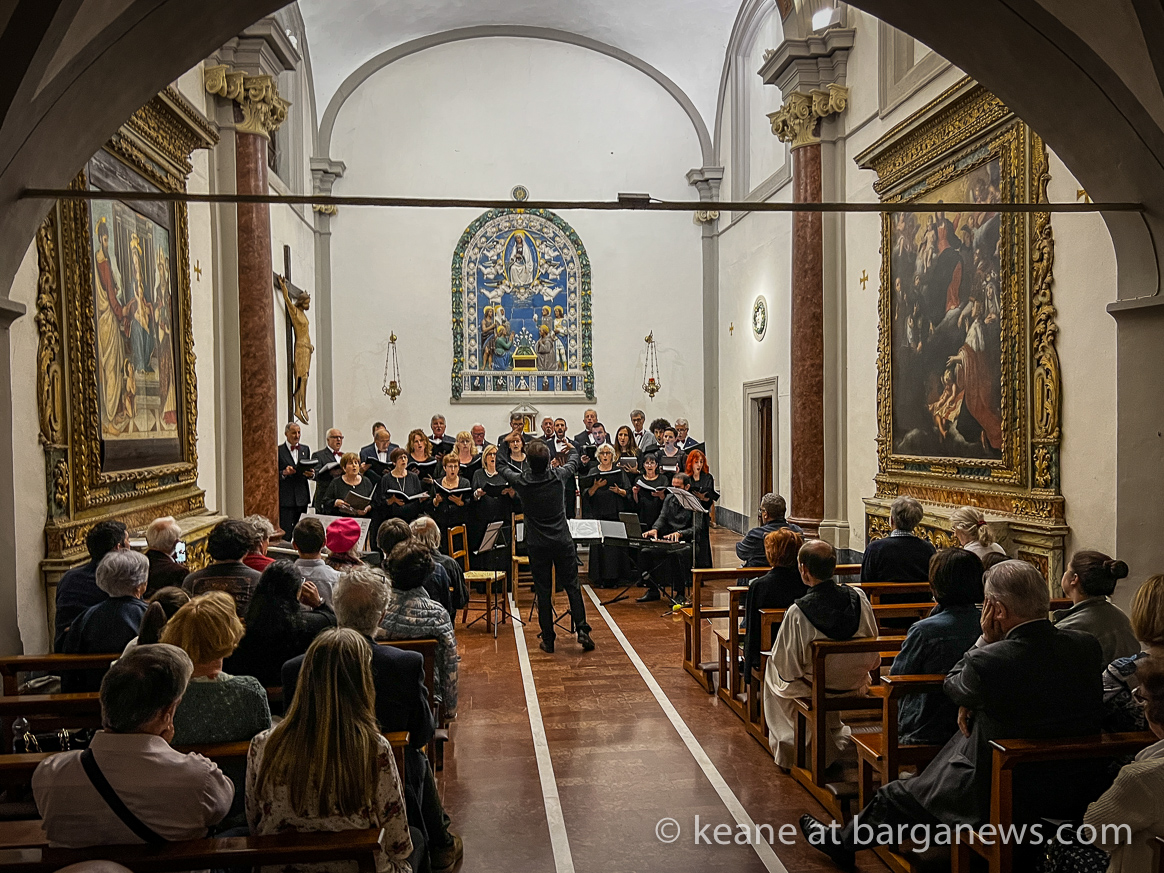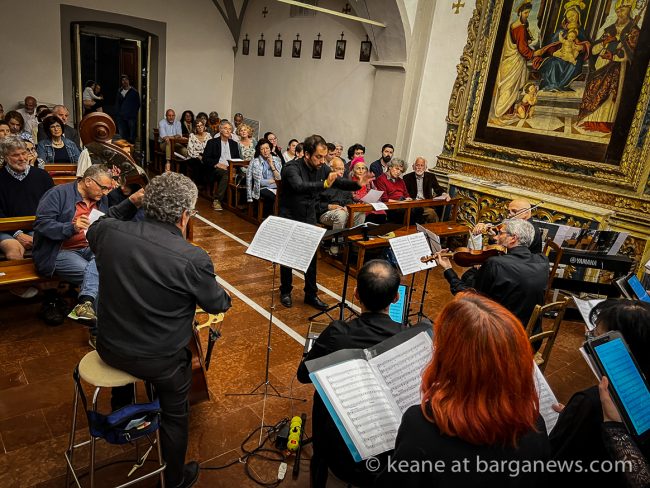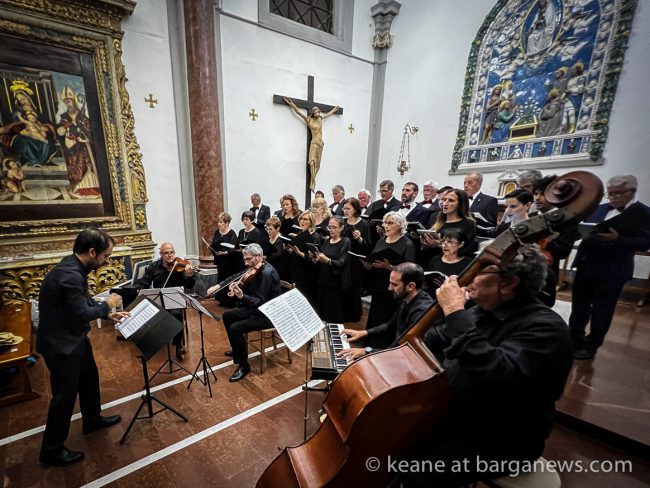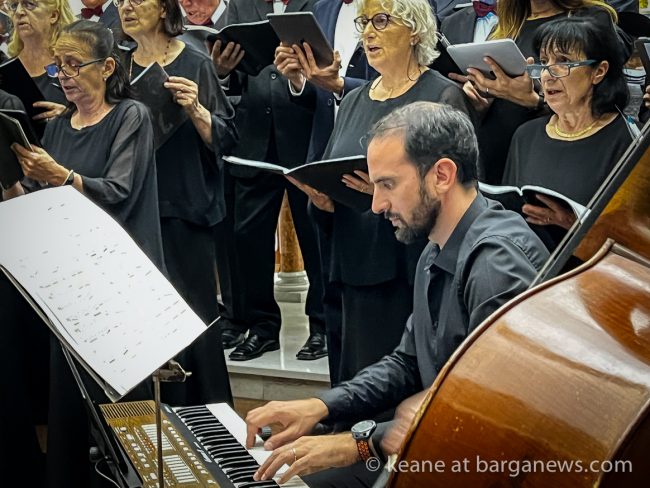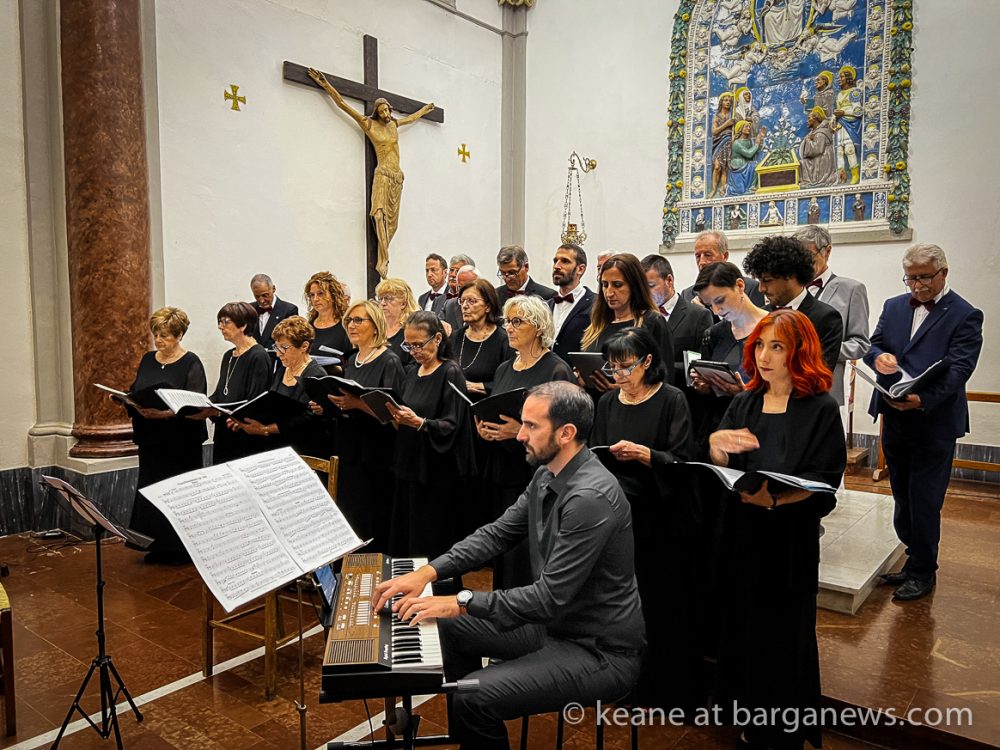A New Axis is Formed
Last night, in the sweet chapel of Barga’s Santa Elisabetta conservatoire, two choirs from two diverse cultures gave of their best in a very varied programme. The Santa Cecilia choir from Diecimo under the directorship of Andrea opened the concert with a powerful rendering of Lorenzo Perosi’s Magnificent. Ordained a priest at 22 Perosi’s friends included Mascagni and Puccini (who remarked that “there is more music in Perosi’s head than mine and Mascagni’s put together”). Lorenzo’s compositions are mainly religious in character and, after a period of neglect, he is now receiving renewed attention as befits one whose many admirers included Debussy.
Andrea’s conducting is precise and emphatic. He conducted the choir’s next piece, Robert Fuhrer’s Caecilienmesse, with real élan. I had never come across Fuhrer’s (1807-61) music before and felt it sounded a bit like Schubert. I subsequently found out that the Czech composer had a dubious streak in him and on one occasion had indeed passed a Schubert Mass as his work. Fuhrer also flogged a Stradivarius violin belonging to his church as his own in order to finance his extravagant life-style. Robert’s music was, however, much loved in his time and I found this wonderfully concise Mass, excellently performed by Andrea’s singers, rather endearing in style.
A change of atmosphere entered the baroque chapel with ten folk and popular songs from Munich’s Sonntagschor. I particularly enjoyed the arrangements of Bacharach’s ‘I say a little prayer’ and Simon’s evergreen ‘Sound of Silence’. The singing was well-balanced and most tuneful under Carola Palleis’s direction and Johanna Raymont’s excellent piano accompaniment.
It was a stroke of absolute genius for the choirs to combine in the last section of the evening’s performance. First came a refulgent rendering of a Sanctus by J. S. Bach. The moving alpine hymn ‘Signore delle Cime’ followed with the Italian words easefully sung by both choirs. A Bach chorale succeeded with German words sung with comfort by both the Italians and Bavarians Finally the pièce de resistance arrived in the form of Bach’s ever-loved chorale ‘Jesu joy of man’s desiring’ with the choir accompanied by a small instrumental ensemble consisting of organ two violins and double bass. An encore was rightfully demanded for this piece and few among the very-well attended audience would have minded if it had been performed a third time!
It was approaching midnight when we left the conservatoire to tread the steep streets of Barga’s old town after what I regard as an inspiring choral concert with all participants (and particularly the choirmasters Andrea Salvoni and Carola Palleis) contributing their very best.
Music remains one of the greatest of psychic healers. To think that not that long ago Barga was being bombed by the same nation that was now invited to sing in this most beautiful of Italian borghi! Will there ever come a time when both Russians and Ukrainians will be able to do the same I wondered…
Complete article by Francis Pettitt can be seen here
Francis Pettitt
I have lived in a village in the Bagni di Lucca area since 2005. In these posts I describe some of my experiences and activities in this lovely part of the world and my trips beyond. I am a free-lance English language teacher and writer, and enjoy walking, vegetable gardening, raising ducks and rabbits, choir-singing and having a generally good time.
Chiesa del conservatorio di Santa Elisabetta
Coro “Sonntagschor” di Monaco di Baviera
Johanna Raymont: pianoforte | Direttrice: Carola Palleis | musiche da Bach a Billy Joel
Corale Santa Cecilia di Diecimo
Antonio Giannini, Antonio Paladini: violini |C Fabrizio Luciani: contrabbasso | Maurizio Pierini: organo | Direttore: Andrea Salvoni
 |
 |
 |
 |
Si forma una nuova asse
La scorsa notte, nella dolce cappella del conservatorio Santa Elisabetta di Barga, due cori provenienti da due culture diverse hanno dato il meglio di sé in un programma molto vario. Il coro di Santa Cecilia di Diecimo, diretto da Andrea, ha aperto il concerto con una potente esecuzione di Magnificat di Lorenzo Perosi. Ordinato sacerdote a 22 anni, Perosi aveva amici come Mascagni e Puccini (che affermò: “Nella testa di Perosi c’è più musica di quella mia e di Mascagni messi insieme”). Le composizioni di Lorenzo sono principalmente di carattere religioso e, dopo un periodo di trascuratezza, sta ricevendo nuovamente attenzione, come meritano coloro che lo ammiravano, tra cui Debussy.
La direzione di Andrea è precisa ed enfatica. Ha poi diretto il prossimo pezzo del coro, la Caecilienmesse di Robert Fuhrer, con vero slancio. Non avevo mai sentito la musica di Fuhrer (1807-61) prima d’ora e mi è sembrata un po’ simile a quella di Schubert. In seguito ho scoperto che il compositore ceco aveva un lato dubbio e in una occasione aveva effettivamente fatto passare una Messa di Schubert come sua. Fuhrer aveva anche venduto come proprio un violino Stradivari appartenente alla sua chiesa al fine di finanziare il suo stile di vita extravagante. La musica di Robert, però, era molto amata al suo tempo e ho trovato questa Messa meravigliosamente concisa, eseguita in modo eccellente dai cantanti di Andrea, piacevolmente affascinante nello stile.
Un cambiamento di atmosfera è entrato nella barocca cappella con dieci canzoni popolari e folk del coro Sonntagschor di Monaco. Ho apprezzato particolarmente gli arrangiamenti di “I say a little prayer” di Bacharach e l’evergreen “Sound of Silence” di Simon. Il canto era ben bilanciato e molto melodioso sotto la direzione di Carola Palleis e con l’eccellente accompagnamento al piano di Johanna Raymont.
È stata una mossa di assoluta genialità far unire i cori nell’ultima parte dello spettacolo serale. Prima è arrivata una splendida esecuzione del Sanctus di J. S. Bach. Seguì l’emozionante inno alpino “Signore delle Cime” con le parole italiane cantate con grazia da entrambi i cori. Poi un corale di Bach con le parole tedesche cantate con sicurezza sia dagli italiani che dai bavaresi. Infine è arrivato il pezzo forte nella forma del tanto amato corale di Bach “Jesu, gioia degli uomini” con il coro accompagnato da un piccolo ensemble strumentale composto da organo, due violini e contrabbasso. È stato giustamente richiesto un bis per questo brano e pochi tra il pubblico molto numeroso avrebbero disapprovato se fosse stato eseguito una terza volta!
Era quasi mezzanotte quando abbiamo lasciato il conservatorio per percorrere le ripide strade del centro storico di Barga dopo quello che considero un ispirante concerto corale, con tutti i partecipanti (e in particolare i maestri del coro Andrea Salvoni e Carola Palleis) che hanno dato il massimo.
La musica rimane uno dei più grandi guaritori psichici. Pensare che non molto tempo fa Barga veniva bombardata dalla stessa nazione che ora era invitata a cantare in questo bellissimo borgo italiano! Mi chiedevo se arriverà mai il momento in cui russi e ucraini potranno fare lo stesso…

